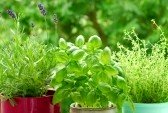Clumped Clay Organic Seeds

How great if we could grow our own organic tomatoes, herbs and beautiful edible flowers with ease. I always wanted to and tried but, I lived on a mountain and my soil is a bit too rocky to grow tomatoes (it is also considered a fruit), herbs and even some flowers; but, I just found out that Clumped Clay Organic Seeds grow quickly and now I can have my plants , herbs and flowers that I dreamed about and so can you. I always run out of some herbs when cooking; now I can have all my lovely plants right here at my home. My family loves my cooking with all the great natural herbs and vegetables that I use ;especially my son-just one thing missing and he knows and he complains. Also I will save a lot of money.
Even if you live in a high rise apartment you could grow now these great Clumped Clay Organic Seeds in large clay planter pot on your terrace; it would look lovely and be such a convenience and also save you a lot of money.
According to Seedman (com), he stated that plants will grow well in heavy clay soils because plants such as fruit and nut plant seeds are fairly lime tolerant. “They are very easily propagated from seed and is relatively fast growing -organic products won’t burn or damage plants.” Also according to Wild Flower Farm, “Clay soils are commonly known as “heavy” soils consisting of very small packed soil particles, clays tend to be dense and hard to work. However, generally rich in nutrients, have a high water-holding capacity, and can be very productive. “Adding organic matter helps to “open up” clay soils by improving porosity or “breath ability”.” This increases water infiltration and air movement through the soil, which is critical for good root growth.” There are many prairie plants that can grow in clay soils, such as our “Clay Busters”. With good initial care, these wildflowers and grasses will flourish even on difficult sites. Their roots will gradually work their way down into the clay, opening and improving it, just as these plants have done for thousands of years.” “After planting in clay soil, we recommend: Mulching with weed free straw (clean winter wheat, oat or marsh hay) to hold in moisture and prevent drying. Mulch 2-3” deep for transplant with openings for the emerging leaves. For seeded areas, 1-2 inches of mulch will help to maintain upper soil moisture. Regular light watering of prairie seedlings for the first 2 months will greatly increase germination and seedling survival. Water when the surface starts to dry out. Mulched areas require less frequent watering. Water only in the morning to help prevent disease problems. Do not over water. Clay soils hold moisture well and drain down slowly.”
I wish you all happy planting and I can’t wait to taste the delicious fresh herbs, tomatoes and edible flowers. Remember today is the last day of our grand opening sale: you will save 30% + no shipping in the United States on all Organic Products just use our code: Wisdomsq at your checkout. I am thanking-you, B I Alsieux!
Enjoy what you just read? Why not get updates from Parental World Knowledge... just enter your email below!
comments powered by Disqus